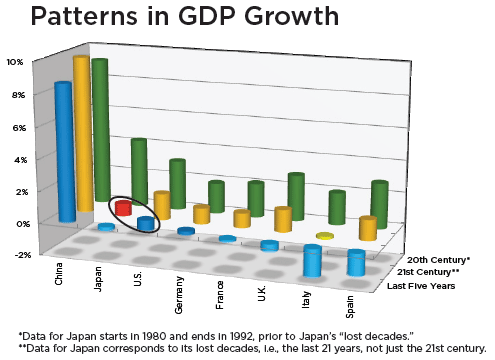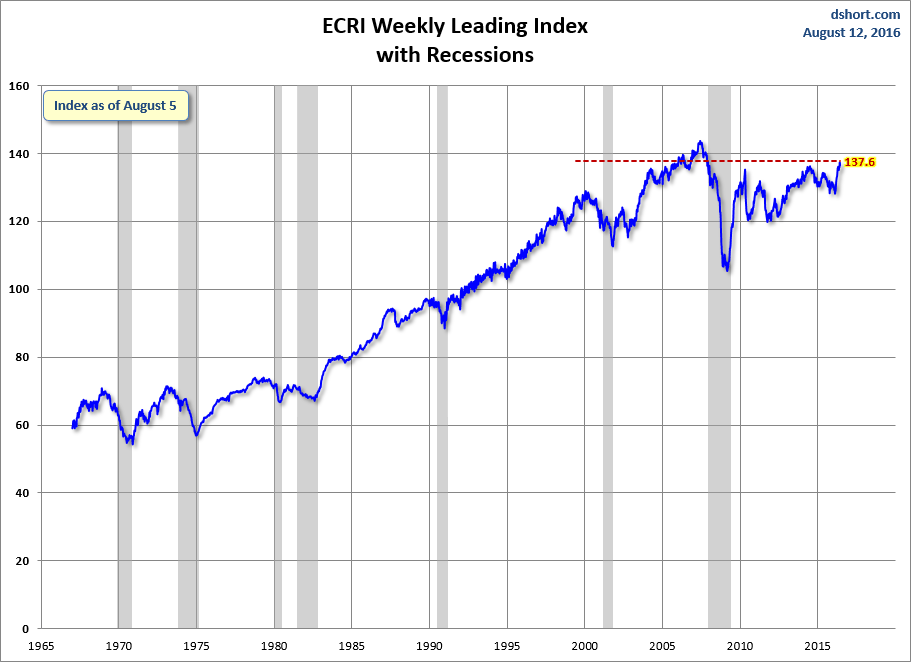The Weekly Leading Index (WLI) of the Economic Cycle Research Institute (ECRI) is at 131.8, essentially unchanged from last week's 131.7 (a downward revision from 131.8). The WLI annualized growth indicator (WLIg) rose to 5.3 from last week's 4.9%.
Last year ECRI switched focus to their version of the Big Four Economic Indicators that I routinely track. But when those failed last summer to "roll over" collectively (as ECRI claimed was happening), the company published a new set of indicators to support their recession call in a commentary entitled The U.S. Business Cycle in the Context of the Yo-Yo Years (PDF format). Subsequently the company took a new approach to its recession call in a publicly available commentary on the ECRI website: What Wealth Effect?. That commentary includes a brief discussion of the Personal Consumption Expenditure (PCE) deflator, which I've discussed in more detail here. It also includes an illustration of the shrinkage in US imports since the post-recession peak nearly three years ago.
At the end of July the company posted a new commentary, Becoming Japan, which highlights the decline in GDP growth for Japan and seven other major economies, including the US.
The commentary concludes with a persuasive observation:
The bottom line: around the world, long-term trends in growth have downshifted, already resulting in weaker recoveries and more frequent recessions than most had expected when the 21st century began. The response, following Japan's example, has been more and more quantitative easing, which has been unable to break this pattern of long-term declines in trend growth.
But to those betting on a return to much stronger trend growth, either after the end of deleveraging or after policy changes, it is simply not convenient to recognize that the downshifts in growth are global in nature, and predated both the GFC [Global Financial Crisis] and supposed policy mistakes.
ECRI posts its proprietary indicators on a one-week delayed basis to the general public, but last year the company switched its focus to a version of the Big Four Economic Indicators I've been tracking for the past year. In recent months, however, those indicators have slipped below the fold, replaced by the mixed bag of whatever Indicator du Jour might look recessionary, as in the "Yo-Yo Years" commentary linked above. Likewise, see this March 7th Bloomberg video. At about the 2-minute point, company's spokesman, Lakshman Achuthan, reasserts his call that a recession began in the middle of 2012. In previous interviews he has specifically mentioned July as the business cycle peak, thus putting us in the 12th month of a recession.
Achuthan's most recent Bloomberg appearance on July 30th (available here) sticks to his recession call and reiterates his expectations that future GDP revision will provide supporting data for the company's position.
Here is a chart of ECRI's data that illustrates why the company's published proprietary indicator has little credibility as a recession indicator. It's the smoothed year-over-year percent change since 2000 of their weekly leading index. I've highlighted the 2011 date of ECRI's recession call and the hypothetical July business cycle peak, which the company claims was the start of a recession. 
Here are three significant developments since ECRI's public recession call on September 30, 2011:
- The S&P 500 is up 45.5%, after setting a series of new all-time high.
- The unemployment rate has dropped from 9.0% to 7.4%.
- Even the dovish members of the Fed are signaling a near-term start of QE tapering.
Ultimately my opinion remains unchanged: The ECRI's credibility depends on major downward revisions to the key economic indicators. The July annual revisions to GDP weren't adequate to substantiate ECRI's position. On the other hand, I would point out that a standard data manipulation of Real GDP, the rear-view mirror on the economy that popular thought associates with recession calls, underscores current economic weakness. I'm referring to the year-over-year percent change (the chart below). I pointed out in my latest GDP update that the current data point is lower than the onset of all recessions except the one that started in January 1980, with which, at two decimal places, it's tied.
Earlier this week Craig Eyermann of Political Calculations offered an interesting take on what he terms a "microrecession" that began in the middle of 2012, coincident with ECRI's claimed recession start date. His analysis is based on the number of US companies posting decreasing dividends.
By our definition, a microrecession represents a period of slow or negative economic growth for the nation that is either too limited in scope, severity or duration to qualify as an official period of recession, as might be determined by the National Bureau of Economic Research
[link to article].
For alternatives to ECRI's recession forecasting, see method developed by Anton and Georg Vrba:
See also Dwaine Van Vuuren's latest RecessionALERT indicator snapshot:
Appendix: A Closer Look at the ECRI IndexDespite the increasing irrelevance of the ECRI's recession indicators in recent years, let's check them out. The first chart below shows the history of the Weekly Leading Index and highlights its current level.
For a better understanding of the relationship of the WLI level to recessions, the next chart shows the data series in terms of the percent off the previous peak. In other words, a new weekly high registers at 100%, with subsequent declines plotted accordingly.
As the chart above illustrates, only once has a recession occurred without the index level achieving a new high -- the two recessions, commonly referred to as a "double-dip," in the early 1980s. Our current level is 11.9% off the most recent high, which was set over five years ago in June 2007. We're now tied with the previously longest stretch between highs, which was from February 1973 to April 1978. But the index level rose steadily from the trough at the end of the 1973-1975 recession to reach its new high in 1978. The pattern in ECRI's indictor is quite different, and this has no doubt been a key factor in their business cycle analysis.
The WLIg Metric
The best known of ECRI's indexes is their growth calculation on the WLI. For a close look at this index in recent months, here's a snapshot of the data since 2000.
Now let's step back and examine the complete series available to the public, which dates from 1967. ECRI's WLIg metric has had a respectable record for forecasting recessions and rebounds therefrom. The next chart shows the correlation between the WLI, GDP and recessions.
The History of ECRI's Latest Recession Call
ECRI's weekly leading index has become a major focus and source of controversy ever since September 30, 2011, when ECRI publicly announced that the U.S. is tipping into a recession, a call the Institute had announced to its private clients on September 21st. Here is an excerpt from the announcement:
Early last week, ECRI notified clients that the U.S. economy is indeed tipping into a new recession. And there's nothing that policy makers can do to head it off.
ECRI's recession call isn't based on just one or two leading indexes, but on dozens of specialized leading indexes, including the U.S. Long Leading Index, which was the first to turn down — before the Arab Spring and Japanese earthquake — to be followed by downturns in the Weekly Leading Index and other shorter-leading indexes. In fact, the most reliable forward-looking indicators are now collectively behaving as they did on the cusp of full-blown recessions, not "soft landings." (Read the report here.)
Year-over-Year Growth in the WLI
Triggered by another ECRI commentary, Why Our Recession Call Stands, I now include a snapshot of the year-over-year growth of the WLI rather than ECRI's previously favored method of calculating the WLIg series from the underlying WLI (see the endnote below). Specifically the chart immediately below is the year-over-year change in the 4-week moving average of the WLI. The red dots highlight the YoY value for the month when recessions began.
The WLI YoY is 7.4%. This is substantially higher than at the onset of all recessions in the chart timeframe, but fractionally off its 7.5% interim high set six weeks ago. The second half of the early 1980s double dip, which was to some extent an engineered recession to break the back of inflation, is a conspicuous outlier in this series, and it started at a lower WLI YoY of 4.1%.
Additional Sources for Recession Forecasts
Dwaine van Vuuren, CEO of RecessionAlert.com, and his collaborators, including Georg Vrba and Franz Lischka, have developed a powerful recession forecasting methodology that shows promise of making forecasts with fewer false positives, which I take to include excessively long lead times, such as ECRI's September 2011 recession call.
Here is today's update of Georg Vrba's analysis, which is explained in more detail in this article.
Earlier Video Chronology of ECRI's Recession Call
- September 30, 2011: Recession Is "Inescapable" (link)
- September 30, 2011: Tipping into a New Recession (link)
- February 24, 2012: GDP Data Signals U.S. Recession (link)
- May 9, 2012: Renewed U.S. Recession Call (link)
- July 10, 2012: "We're in Recession Already" (link)
- September 13, 2012: "U.S. Economy Is in a Recession" (link)
Note: How to Calculate the Growth series from the Weekly Leading Index
ECRI's weekly Excel spreadsheet includes the WLI and the Growth series, but the latter is a series of values without the underlying calculations. After a collaborative effort by Franz Lischka, Georg Vrba, Dwaine van Vuuren and Kishor Bhatia to model the calculation, Georg discovered the actual formula in a 1999 article published by Anirvan Banerji, the Chief Research Officer at ECRI: "The three Ps: simple tools for monitoring economic cycles - pronounced, pervasive and persistent economic indicators."
Here is the formula:
"MA1" = 4 week moving average of the WLI
"MA2" = moving average of MA1 over the preceding 52 weeks
"n"= 52/26.5
"m"= 100
WLIg = [m*(MA1/MA2)^n] – m
